The best wild mushrooms for beginners
The world of mushrooms and fungi can be an intimidating place for beginners so through this guide we’re going to look at the best wild mushrooms for beginners.
Many of them look very similar and if you get it wrong there’s the risk of poisoning yourself.
It’s such a vast kingdom of life with its own rules and patterns that can take years to get your head around.
The shape, colour and appearance of many mushrooms can change depending on how mature they are and it’s sometimes hard to grasp that the huge fruiting body that you found today is the same species as that tiny thing you saw last week.
Most people in the UK are scared of mushrooms
We are traditionally very mycophobic (the technical name for the fear of mushrooms) in the UK, when you’re young and you see a mushroom your mum is screaming at you don’t touch it! It’ll kill you! They are associated with witchcraft, the devil and evil beings. We know that some can kill you, harm you or make you hallucinate. All of which causes fear and this fear at least keeps us safe but with a little bit of knowledge and some common sense it can be a rewarding and delicious pastime.
Many mushrooms are extremely difficult to identify and some can only be identified using chemicals, microscopes or DNA sequencing which are beyond the realms of most of us.
However there are some species that can be easily identified even by complete novices. On courses we teach people to identify the key fungal families and to spend time focusing on the families that contain few or no toxic species and to ignore families that are known to have many poisonous species and few edibles. Once you get started you’ll get hooked and the whole kingdom of fungi will open up to you.
Here are the 5 easiest to ID edible mushrooms found in the UK;
Giant puffballs (Calvatia gigantea)
The only thing this fungus could be confused with would be a football or another member of the puff ball family which is not an issue as all puffballs are edible when they are young. They are tasty and make amazing vegan schnitzels.
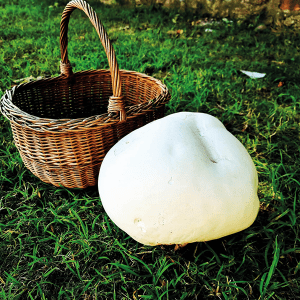
Hedgehog mushroom (Hydnum Repandum)
Growing on the forest floor with spines there is very little it can be mistaken for other than the closely related Terracotta Hedgehog, (Hydnum Rufescens) which is a darker member of the same family and it’s also edible.
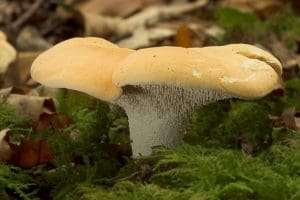
Porcini (Boletus edulis)
They grow on the forest floor, have a domed cap, a stout stem and have spongy pores rather than gills. Any mushroom with these features in in the Bolete family. As long as you avoid any bolete that has red or blue staining on it, the potential lookalikes are all safe to eat and nearly as tasty.
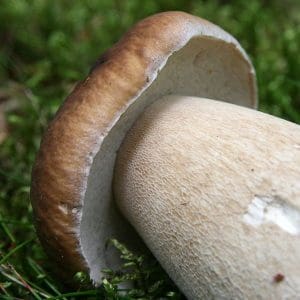
Jelly Ears (Auricularia auricula-judae)
There are some similar looking mushrooms, but if you harvest them only from Elder trees then you can be sure it’s a Jelly Ear. I love these mushrooms and use them in Asian soups and stews, powdered and mixed with salt as a seasoning and in deserts.
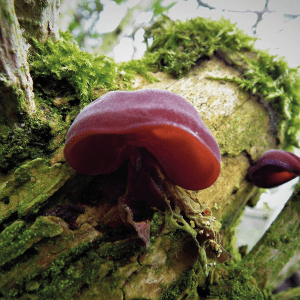
Scarlet Elf Cups (Sarcoscypha austriaca)
Found in larger quantities in the winter and spring, they grow on dead hazel and willow. The only similar looking mushroom is the Ruby Elf Cup (Sarcoscypha coccinea) the differences are microscopic and they are both edible.
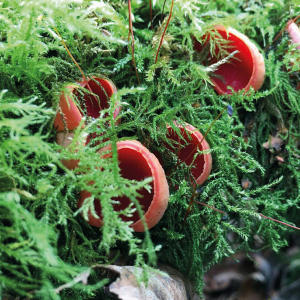
None of the above mushrooms have poisonous lookalikes but remember unless you are 100% of the ID of any plant or mushroom do not eat it! As the old saying goes all mushrooms are edible at least once.
So through this guide on Edible Mushrooms we’ve taken a look at:
- getting started on mushrooms
- how I started look at mushrooms
- the best species to look for to begin
- edible mushrooms that have no toxic lookalike
Good luck and happy foraging!




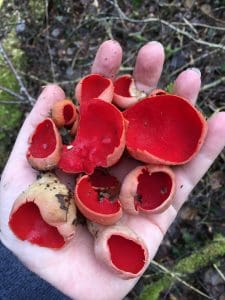
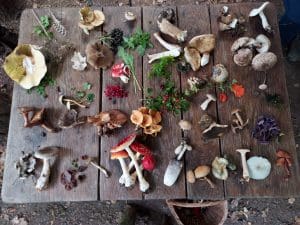



Leave a Reply
You must be logged in to post a comment.